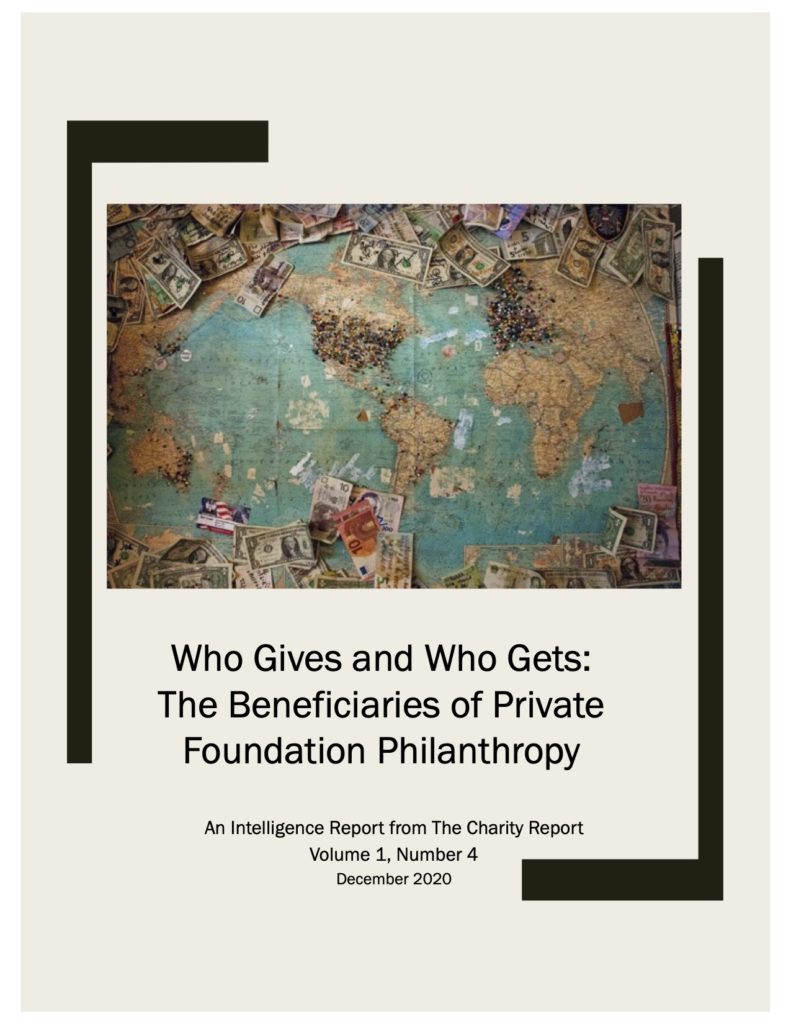
(December 14, 2020) Since the July 2020 Intelligence Report, Where Wealth Resides, subscribers and readers have said they would like to see a deeper dive into where private foundations spend their money. Who exactly benefits from their largesse? By how much?
Today, The Charity Report has released a follow-up report called Who Gives and Who Gets: The Beneficiaries of Private Foundation Philanthropy, which looks at the grant recipients for the Top 20 Private Foundations in Canada from 2014 to 2018. (These 20 foundations represent 75% of the total private foundation giving in Canada and help assets of $32 billion.)
How much was spent supporting institutions outside the country was considered, how much was spent on education, how much was spent for community benefit. The report identifies the Top 10 grant recipients in a number of broader categories such as health, education and community benefit, and the demographic served by the grant recipient.
Key findings include:
- The most recent five years of data revealed the top 20 private foundations in Canada gave a total $1.63 billion in grants
- 34.7% ($565 million) were given to benefit institutions operating outside Canada, mostly post-secondary institutions, such as Oxford University, Stanford University, etc.
- 47.5% ($762 million) was primarily spent on post-secondary institutions in Canada and around the world
- 19.3% ($314.5 million) went to Health Charities
- 32% ($100.4) of Health Charity spending was to hospital foundations
- 7.2% of grants went to charities benefiting communities. Among the Top 10 grants recipients in this category were the Fraser Institute and the MaRS Discovery District.
- 0.2% of funding went to support Indigenous organizations
- 0.1% of grants went to supporting racialized communities
The Top 3 grant recipients were Technion – Israel Institute of Technology, which received $88.7 million; the University of Toronto, which received $58.6 million; and the Heseg Foundation, which received $45.3 million, and whose mission, according to it’s website, is to support “lone soldiers” who fight for the Israeli Defense Force (IDF). A lone soldier is defined as someone who comes from another country to join the IDF. The CRA categorizes The Heseg Foundation as an Education charity.
“The entire process of conducting this research was surprising,” says Gail Picco, editor in chief of The Charity Report. “We actually thought the report would be pretty straightforward, but it wasn’t.
“Like most people conducting big-picture research into the charity sector, we used T3010 data. During our research, however, we found that the information about grant recipients submitted to CRA by these Top 20 foundations was extremely messy, and sometimes the grants bore little relation to the foundation’s stated purpose.
Among the challenges to determining where private foundations spend their money, the researchers noted that the foundations’ reporting on qualified donees didn’t follow a specific format or include the Business Number of the qualified donee, which meant there was no unique identifier for the charity receiving funds. Some recipient names were abbreviated, some missing key words, some used only an acronym, many did not include a town, province or even country. And these irregularities all existed within one return. Not infrequently, this made the job of pinpointing the exact charity receiving funds challenging, and a significant amount of manual labour was required to find the correct information. Apparent typos worth tens of millions of dollars were found.
“For organizations representing a collective $32 billion in assets, we were surprised,” says Picco. “And one can’t say they don’t have the resources needed to accurately fill in these forms. It could give the impression these foundations don’t take their reporting requirements as seriously as they might. And, of course, it makes information harder to get, because very few people would do what we did to get to the bottom of this information, and I salute our researchers for that.”
The biggest conclusion the report suggests is that, even if the disbursement quota was raised, based on where private foundations spend their money right now, as indicated by the Top 20 foundations in Canada, very little of those funds would reach the people who needed it most.
To become a subscriber to The Charity Report and receive all our intelligence reports, please visit the subscriber page.